Edward Benjamin Herberte, often signing his works as E. B. Herberte, stands as a notable, if somewhat enigmatic, figure in the vibrant tapestry of 19th-century British art. Active during the latter part of the Victorian era, Herberte carved a distinct niche for himself as a painter of sporting and animal subjects, with a particular emphasis on the dynamic and socially rich world of equestrian pursuits. His canvases bring to life the thrill of the hunt, the pageantry of race meetings, and the intimate connection between rider and horse, all rendered with a keen eye for detail and a palpable sense of energy.
The Artist's Identity and Era
Born in 1857, Edward Benjamin Herberte's life (1857-1893) coincided with a period of immense social and industrial change in Britain, yet also a time when traditional rural pastimes, particularly those involving horses, held a cherished place in the national identity. While precise details about his early life and artistic training remain somewhat scarce, his body of work firmly places him within the strong tradition of British sporting art. It is generally accepted that he was a British artist, likely English, given the settings and themes prevalent in his paintings. Unlike many of his contemporaries who sought recognition through major London exhibitions like those at the Royal Academy, Herberte appears to have primarily worked on private commissions, catering to a clientele passionate about the subjects he depicted. This mode of operation might explain why his name is not as broadly recognized as some other Victorian painters, yet his skill and the appeal of his work have ensured his continued appreciation among collectors and enthusiasts of sporting art.
The Rich Heritage of British Sporting Art
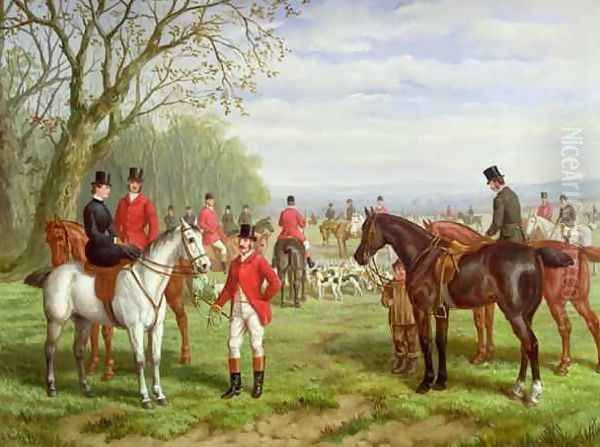
To fully appreciate Herberte's contribution, it is essential to view his work against the backdrop of Britain's long and distinguished history of sporting art. This genre, which gained significant traction in the 18th century, celebrated the nation's love for outdoor pursuits. Artists like George Stubbs (1724-1806), with his unparalleled anatomical understanding of horses, laid a formidable foundation. Following him, painters such as Benjamin Marshall (1768-1835) captured the character and spirit of racehorses and their owners. The 19th century saw this tradition flourish further. The Alken family, particularly Henry Thomas Alken (1785-1851), became synonymous with lively hunting, coaching, and racing scenes, often imbued with a touch of caricature and social commentary.
By the time Herberte was active, the demand for sporting art was well-established, fueled by a landed gentry and a rising middle class who participated in or aspired to these activities. Artists like John Frederick Herring Sr. (1795-1865) and his son, John Frederick Herring Jr. (1820-1907), were immensely popular for their depictions of farmyard scenes, coaching, and, most famously, winners of classic horse races. Sir Edwin Landseer (1802-1873), while known for a broader range of animal subjects often with sentimental or anthropomorphic qualities (like "The Monarch of the Glen"), also contributed to the depiction of Highland sports and animals, setting a high bar for animal portraiture. Herberte, therefore, entered an artistic field with established conventions but also one that offered scope for individual expression and focus.
Herberte's Artistic Focus: The Equestrian World
E. B. Herberte’s oeuvre is predominantly characterized by oil paintings that vividly portray the equestrian culture of his time. His subjects frequently revolved around fox hunting – a popular and socially significant activity – and race meetings, which were major events in the social calendar. His canvases are often populated with numerous figures, both human and equine, creating bustling, animated scenes. He demonstrated a remarkable ability to capture the dynamic movement of horses in full gallop, leaping over fences, or gathered in anticipation at a meet.
His attention to detail was meticulous. The tack of the horses, the attire of the riders, the varied expressions of participants, and the nuances of the British landscape are all rendered with care. This precision not only lends authenticity to his scenes but also provides a valuable visual record of the sporting customs and fashions of the late Victorian period. Herberte’s style is generally realistic, aiming to convey the excitement and atmosphere of the events he portrayed. He was adept at composing complex scenes, managing multiple focal points while maintaining a cohesive and engaging narrative within the painting.
A Pioneering Depiction of Women in Sport
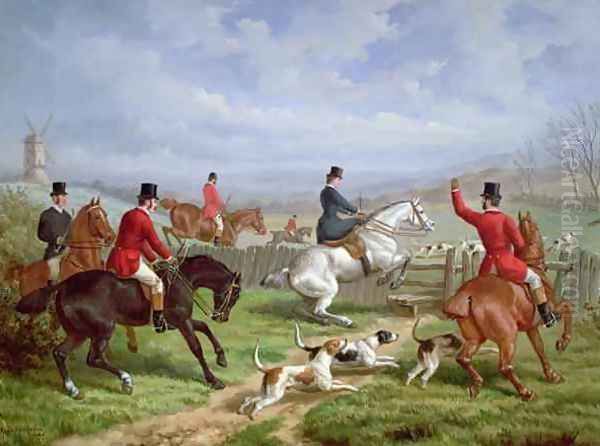
One of the most distinctive and forward-looking aspects of E. B. Herberte's work is his frequent and prominent inclusion of female equestrians. In an era when women's participation in vigorous sports was often viewed through a restrictive lens, Herberte depicted women confidently riding, often side-saddle as was customary, participating actively in hunts and other equestrian events. This was relatively uncommon among sporting artists of his time, many of whom focused predominantly on male participants.
His painting "Meet Up" (1883), for instance, features a lady on a side-saddle horse as a central element, portrayed with elegance and capability. By giving women such visible roles in these traditionally male-dominated scenes, Herberte not only reflected an emerging reality of greater female participation but also subtly challenged conventional representations. In this, his work can be seen as quietly progressive, acknowledging the evolving role of women in society and their engagement with the sporting world. This contrasts with, for example, the powerful but often more domestically or sentimentally framed animal paintings of French contemporary Rosa Bonheur (1822-1899), who, despite her own unconventional life, focused more on the animals themselves or rural labor than women in dynamic sporting action.
Signature Works and Thematic Series
Among E. B. Herberte's most recognized contributions is a series of paintings, often a set of four, depicting the various stages of a fox hunt. A prime example, created in 1885, includes titles such as "The Meet," "Over the Fence," "The Chase," and "The Kill." Such series allowed for a narrative progression, capturing the unfolding drama and different facets of the hunt, from the social gathering at the start to the exhilarating pursuit and the ultimate conclusion.
"The Meet," as a standalone subject or part of a series, was a recurring theme for Herberte. These paintings often showcase a large assembly of riders, hounds, and onlookers, set against a backdrop of a country estate or rural landscape. One such depiction of "The Meet" is particularly noted for its ambition, featuring over one hundred individual figures, each rendered with attention to character and detail, capturing the communal excitement and social interactions inherent in such an event. These works are a testament to his skill in managing complex compositions and imbuing them with a sense of lively realism.
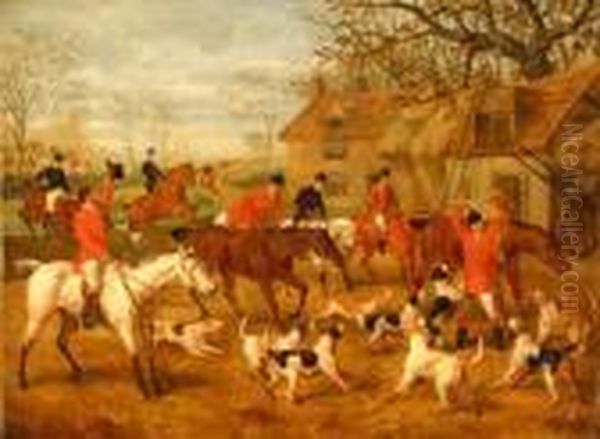
Another notable work is "The Farrier," which shifts the focus from the field to a more intimate scene related to equine care. This painting likely depicts a blacksmith or farrier tending to a horse, highlighting the essential relationship between humans and horses that underpins all equestrian activities. Such a piece demonstrates Herberte's broader interest in the equine world beyond the spectacle of the hunt or race. A pair of landscape oil paintings from 1883, featuring traditional riders, further underscores his commitment to equestrian themes, even within a more pastoral setting.
Contemporaries and the Victorian Art Milieu
While Herberte may have operated somewhat outside the mainstream exhibition circuit, he was working within a vibrant Victorian art world. Beyond the established masters of sporting art, other contemporaries were also exploring animal and sporting themes. Heywood Hardy (1842-1933) was a prolific painter of hunting scenes, 18th-century costume pieces, and animal subjects, known for his fluid style and ability to capture movement. Richard Ansdell (1815-1885), a Royal Academician, was highly regarded for his paintings of animals, sporting scenes (especially from Scotland), and historical subjects. His work often had a dramatic or heroic quality.
Briton Rivière (1840-1920) was another prominent animal painter, often imbuing his subjects with pathos or narrative depth, moving beyond pure sporting representation. John Emms (1843-1912) was particularly renowned for his depictions of dogs, especially foxhounds and terriers, often portrayed with great character and anatomical accuracy within hunting contexts. Thomas Blinks (1853-1910) was a near-contemporary who specialized in highly dynamic and spirited hunting and racing scenes, his work characterized by a sense of speed and energy that resonated with patrons.
The influence of French artists also permeated the British art scene. Alfred de Dreux (1810-1860), though slightly earlier, was celebrated for his elegant equestrian portraits and depictions of horses, influencing the portrayal of aristocratic sporting life. While direct interactions between Herberte and these specific artists are not extensively documented, he would undoubtedly have been aware of their work and the prevailing trends in animal and sporting art. The shared thematic concerns and the competitive market for such paintings suggest an environment of indirect influence and parallel development. Artists like John Sargent Noble (1848-1896) also contributed to the genre with their depictions of animals and sporting life, often focusing on Highland scenes and deer stalking.
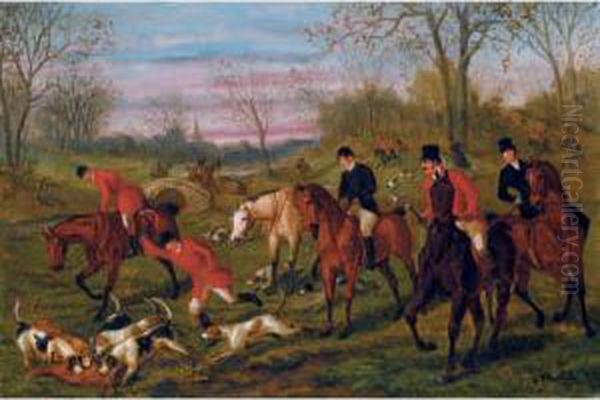
The provided information mentions a Léon Eugène Auguste Abry (1857-1905), a Belgian painter of military and equestrian scenes, and John Frederick Eley (active late 19th century), a British painter of coaching and landscape scenes. While their names appear in auction records alongside Herberte's, indicating they were part of the same art market, specific artistic influence on Herberte from these individuals is not clearly established but points to the broader network of artists working in related fields.
Working Methods and Artistic Legacy
Given the detail and complexity of his compositions, particularly those featuring numerous figures and animals in motion, it is likely that E. B. Herberte undertook considerable preparatory work. This would have involved sketching from life, studying animal anatomy, and carefully planning his compositions. His ability to capture the distinctive characteristics of different horse breeds and the specific attire of riders suggests a close observation of his subjects.
The fact that Herberte primarily worked on commission indicates a direct relationship with his patrons. These clients, often landowners or enthusiasts of field sports, would have valued his ability to accurately and flatteringly depict their prized horses, hounds, and their participation in cherished social rituals. His paintings served not only as works of art but also as records of a particular way of life and as status symbols.
Today, E. B. Herberte's works are found in private collections and occasionally appear at auction, where they are appreciated for their historical charm, technical skill, and evocative portrayal of Victorian sporting life. While he may not have achieved the widespread fame of some of his Royal Academy contemporaries during his lifetime, his paintings offer a valuable and engaging window into a specific aspect of 19th-century British culture. His focus on the dynamic interplay of humans, animals, and landscape, and particularly his inclusion of women in these active scenes, ensures his enduring relevance.
There are no records of his works being involved in major art heists, forgeries, or significant public controversies, which perhaps speaks to his more private, commission-based career. His legacy is that of a skilled and dedicated specialist painter who captured the spirit of his age through the lens of its sporting traditions. Artists like George Wright (1860-1942) and his brother Gilbert S. Wright (1880-1958), though slightly later, continued the tradition of depicting coaching, hunting, and racing scenes with a similar verve, showing the enduring appeal of the subjects Herberte mastered.
Conclusion: An Enduring Eye for Action and Elegance
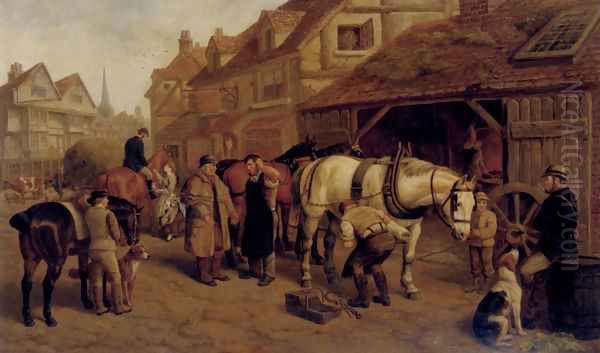
Edward Benjamin Herberte remains a significant painter within the specialized field of British sporting art. His works, characterized by their lively compositions, meticulous detail, and insightful portrayal of equestrian culture, offer more than just depictions of sport; they are social documents, capturing the customs, attire, and atmosphere of late Victorian England. His notable inclusion of women as active participants in these scenes adds a layer of social observation that distinguishes his work.
Though he may have eschewed the limelight of major public exhibitions, the enduring appeal of his paintings, particularly works like "The Meet" series and "Meet Up," speaks to his skill and the timeless fascination with the equestrian world. E. B. Herberte’s canvases continue to evoke the thrill of the chase and the elegance of a bygone era, securing his place among the respected chroniclers of British sporting heritage. His contribution enriches our understanding of 19th-century art and the cultural importance of the horse in British society.